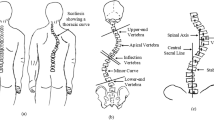Abstract
Choosing the most suitable treatment for the scoliosis relies heavily on accurate and reproducible spinal curvature measurement from radiographs. Our objective is to reduce the variability in spinal curvature measurement by reducing the user intervention and bias. In order to determine the reliability of the spinal curvature measurement as it is in the clinical measurement of scoliosis a methodological survey has been carried out that concludes with inter and intra observer error variation. The proposed method list out horizontal inclination of all the vertebrae’s in terms of slopes using active contour models and morphological operators. This facilitates the radiologist to decide end vertebrae and hence inter/intra observer variation is completely eliminated. Tables 1 and 2 shows the observer error variation between manual and proposed methods in terms of mean and standard deviation.







Similar content being viewed by others
References
Cobb, J., Outline for the study of scoliosis. Ar. Acad. Orthop. Surg. Instr. Course Lect. 5:261–175, 1948.
Nash, C., and Moe, J., A study of vertebral rotation. J. Bone Jt. Surg. Am. 51:223–229, 1969.
Jeffries, B. F., et al., Computerized measurement and analysis of scoliosis. Pediatr. Radiol. 134:381–385, 1980.
Arthur, A., et al., A clinical study of the differences between the scoliotic angles measured on poster anterior and antero posterior radiographs. J. Bone Jt. Surg. 64(A):489–493, 1982.
Pruijis, J. E. H., et al., Variation in Cobb angle measurements in scoliosis. Skelet. Radiol. 23:517–520, 1994.
Diab, K. M., et al., Accuracy and applicability of measurement of the scoliotic angle at the frontal plane by Cobb’s method, by Ferguson’s method and by a new method. Eur. Spine J. 4:291–295, 1995.
Cheung, J., et al., The reliability of quantitative analysis on digital image of the scoliotic spine. Eur. Spine 11:535–542, 2002.
Linial, A. V., and Aktinson, R. W., Methods and apparatus for detection and measurement of scoliosis of the spine, USPatent-US2006/0015042 A1, 2006.
Perona, P., and Malik, J., Scale-space and edge detection using anisotropic diffusion. IEEE Trans. Pattern Anal. Mach. Intell. 12(7), 1990.
Kass, M., et al., Snakes: active contour models. Int. J. Comput. Vis. 9:321–331, 1988.
Xu, C., and Prince, J. L., Snakes, shapes, and gradient vector flow. IEEE Trans. Image Process. 7(3):359–369, 1998.
Vrtovec, T., et al., A review of methods for quantitative evaluation of spinal curvature. Eur. Spine. J., 2009.
Lin, Z., Davis, L. S., Doermann, D., and DeMenthon, D., Hierarchical part-template matching for human detection and segmentation. 978-1-4244-1631-8/07/25.00, IEEE, 2007.
Allen, S., Parent, E., Khorasani, M., Hill, D. L., Lou, E., and Raso, J. V., Validity and reliability of active shape models for the estimation of Cobb angle in patients with adolescent idiopathic scoliosis. J. Digit. Imaging 21(2):208–218, 2008.
Gstoettner, M., Sekyra, K., Walochnik, N., Winter, P., Wachter, R., and Bach, C. M., Inter and intra-observer reliability assessment of the Cobb angle: manual versus digital measurement tools. Eur. Spine J. 16:1587–1592, 2007.
Modi, H. N., Chen, T., Suh, S. W., Mehta, S., Srinivasalu, S., Yang, J.-H., and Song, H.-R., Observer reliability between juvenile and adolescent idiopathic scoliosis in measurement of stable Cobb’s angle. Eur. Spine J. 18:52–58, 2009.
Segev, E., Hemo, Y., Wientroub, S., Ovadia, D., Fishkin, M., Steinberg, D. M., and Hayek, S., Intra and interob server reliability analysis of digital radiographic measurements for pediatric orthopedic parameters using a novel PACS integrated computer software program. J. Child Orthop. 4:331–341, 2010.
Tanure, M. C., Pinheiro, A. P., and Oliveira, A. S., Technical report reliability assessment of Cobb angle measurements using manual and digital. Spine J. 10:769–774, 2010.
Capasso, G., et al., The validity and reliability of measurement of spinal deformity. Acta orthopedia Belgica 58(2):126–135, 1992.
Ian, A. F., et al., Identifying sources of variability in scoliosis classification using a rule-based automated algorithm. SPINE 27(24):2801–2805.
Author information
Authors and Affiliations
Corresponding author
Rights and permissions
About this article
Cite this article
H, A., Prabhu, G.K. Automatic Quantification of Spinal Curvature in Scoliotic Radiograph using Image Processing. J Med Syst 36, 1943–1951 (2012). https://doi.org/10.1007/s10916-011-9654-9
Received:
Accepted:
Published:
Issue Date:
DOI: https://doi.org/10.1007/s10916-011-9654-9




